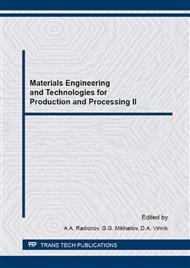[1]
A.R. Mallick, Practical boiler operation engineering and power plant, PHI Learning Pvt. Ltd, (2015).
Google Scholar
[2]
E.R. Zvereva, T.M. Farakhov, Energy-saving processes and equipment of fuel oil-fired TPPs, Teplotekhnik, Moscow, 2012. (in Russian).
Google Scholar
[3]
E.R. Zvereva, Resource and energy-saving technologies in the fuel oil facilities of thermal power plants, KSPEU, Kazan, 2010. (in Russian).
Google Scholar
[4]
R.C. Eliot, Boiler fuel additives for pollution reduction and energy saving, Noyes Data Corp., (1978).
Google Scholar
[5]
A. Groysman, Corrosion in Systems for Storage and Transportation of Petroleum Products and Biofuels: Identification, Monitoring and Solutions, Springer Science & Business Media, (2014).
DOI: 10.1007/978-94-007-7884-9
Google Scholar
[6]
A.M. Danilov, Application of Fuel Additives, Mir, Moscow, 2005. (in Russian).
Google Scholar
[7]
E.R. Zvereva, L.V. Ganina, I.A. Andryushina, An experimental study of the effectiveness of an additive for fuel oil, Thermal Engineering. 57 (2010) 530-533.
DOI: 10.1134/s004060151006011x
Google Scholar
[8]
E.R. Zvereva, I.A. Mutugullina, R.V. Zinnatullina, A.R. Khabibullina, The improvement of furnace fuel oil's rheological properties, Proceedings of the higher educational institutions, Energy Sector Problems. 7-8 (2012) 28-33. (in Russian).
Google Scholar
[9]
E.R. Zvereva, G.R. Mingaleeva, R.V. Khabibullina, G.R. Akhmetvalieva, Improvement in the Viscosity Characteristics of Boiler Oil by Additives, Petroleum Chemistry. 56 (2016) 65-67.
DOI: 10.1134/s0965544115080216
Google Scholar
[10]
E.R. Zvereva, L.V. Ganina, R.V. Zinnatullina, Towards the Mechanism of Carbonaceous Additive Effect on Fuel Oil Properties, Oil and Gas Technologies. 1 (2014) 20-24. (in Russian).
Google Scholar
[11]
E.R. Zvereva, L.V. Ganina, I.A. Andryushina, Effects of additives on the working properties of furnace heavy fuel oils, Chemistry and Technology of Fuels and Oils. 45 (2009) 349-353.
DOI: 10.1007/s10553-009-0145-3
Google Scholar
[12]
E.R. Zvereva, Improving the quality of fuel oil, Butlerov Communications 24. 4 (2011) 97-102.
Google Scholar
[13]
E.R. Zvereva, I.A. Mutugullina, R.V. Zinnatullina, RU Patent 133, 018. (2013).
Google Scholar
[14]
J.S. Basha, R.B. Anand, Role of nanoadditive blended biodiesel emulsion fuel on the working characteristics of a diesel engine, JRSE. 3 (2011) 023106.
DOI: 10.1063/1.3575169
Google Scholar
[15]
T. Shaafi, K. Sairam, A. Gopinath, G. Kumaresan, R. Velra, Effect of dispersion of various nanoadditives on the performance and emission characteristics of a CI engine fuelled with diesel, biodiesel and blends—A review, Renew. Sust. Energ. Rev. 49 (2015).
DOI: 10.1016/j.rser.2015.04.086
Google Scholar
[16]
J.S. Basha, R.B. Anand, Experimental Investigations on the Effects of Cerium Oxide Nanoparticle Fuel Additives on Biodiesel, J. Braz. Soc. Mech. Sci. 35 (2013) 257-264.
Google Scholar
[17]
A. Selvaganapthy, A. Sundar, B. Kumaragurubaran, P. Gopal, An Experimental Investigation to Study the Effects of Various Nano Particles with Diesel on Di Diesel Engine, ARPN Journal of Science and Technology. 3 (2013) (2013).
Google Scholar
[18]
G.R. Kannan, R. Karvembu, R. Anand, Effect of metal based additive on performance emission and combustion characteristics of diesel engine fuelled with biodiesel, Applied Energy. 88 (2011) 3694-3703.
DOI: 10.1016/j.apenergy.2011.04.043
Google Scholar
[19]
W.M. Yang, H. An, S.K. Chou, S. Vedharaji, R. Vallinagam, Emulsion fuel with novel nano-organic additives for diesel engine application, Fuel. 104 (2013) 726-731.
DOI: 10.1016/j.fuel.2012.04.051
Google Scholar
[20]
H.S. Jung, A. Miller, K. Park, D.B. Kittelson. Carbon nanotubes among diesel exhaust particles: real samples or contaminants? J. Air. Waste Manag. Assoc. 63 (2013) 1199-1204.
DOI: 10.1080/10962247.2013.812048
Google Scholar
[21]
P. Tewari, E. Doijode, N.R. Banapurmath, V.S. Yaliwal, Experimental Investigations on a Diesel Engine Fuelled with Multiwalled Carbon Nanotubes Blended Biodiesel fuels, IJETAE. 3 (2013) 72-76.
Google Scholar
[22]
W. Zhang, H. Zhang, J. Xiao, Z. Zhao, М Yua. Z. Li, Carbon nanotube catalysts for oxidative desulfurization of a model diesel fuel using molecular oxygen, Green Chem. 16 (2014) 211-220.
DOI: 10.1039/c3gc41106k
Google Scholar
[23]
N. Singh, R.S. Bharj, Experimental investigation on the role of indigenous carbon nanotube emulsified fuel in a four-stroke diesel engine, Proc. I. Mech. E. Part C: Journal of Mechanical Engineering Science. (2015) 0954406215586021.
DOI: 10.1177/0954406215586021
Google Scholar
[24]
D. Schuster, Encyclopedia of Emulsion Technology: Applications, CRC Press, (1985).
Google Scholar
[25]
A.O. Borovskaya, B.Z. Idiatullin, O.S. Zueva, Carbon nanotubes in the surfactants dispersion: formation of the microenvironment, JPCS. 690 (2016) 012030.
DOI: 10.1088/1742-6596/690/1/012030
Google Scholar
[26]
O.S. Zueva, O.N. Makshkova, B.Z. Idiyatullin, D.A. Faizullin, N.N. Benevolenskaya, A.O. Borovskaya, E.A. Sharipova, Yu.N. Osin, V.V. Salnikov, Yu.F. Zuev, Structure and properties of aqueous dispersions of sodium dodecyl sulfate with carbon nanotubes, Russ. Chem. Bull. (Int. Ed. ). 65 (2016).
DOI: 10.1007/s11172-016-1437-5
Google Scholar
[27]
A.T. Gubaidullin, I.A. Litvinov, A.I. Samigullina, O.S. Zueva, V.L. Rukhlov, B.Z. Idiyatullin, Yu.F. Zuev, Structure and dynamics of concentrated micellar solutions of sodium dodecyl sulfate, Russ. Chem. Bull. (Int. Ed. ). 65 (2016) 158-166.
DOI: 10.1007/s11172-016-1278-2
Google Scholar
[28]
Yu.F. Zuev, O.I. Gnezdilov, O.S. Zueva, O.G. Us'yarov, Effective self-diffusion coefficients of ions in sodium dodecyl sulfate micellar solutions, Colloid J. 73 (2011) 59-64.
DOI: 10.1134/s1061933x11010224
Google Scholar
[29]
O.I. Gnezdilov, Yu.F. Zuev, O.S. Zueva, Self-Diffusion of Ionic Surfactants and Counterions in Premicellar and Micellar Solutions of Sodium, Lithium and Cesium Dodecyl Sulfates as Studied by NMR-Diffusometry, Appl. Magn. Reson. 40 (2011) 91-103.
DOI: 10.1007/s00723-010-0185-1
Google Scholar
[30]
B.Z. Idiyatullin, K.S. Potarikina, Yu.F. Zuev, O.S. Zueva, O.G. Us'yarov, Association of sodium dodecyl sulfate in aqueous solutions according to chemical shifts in 1H NMR spectra, Colloid J. 75 (2013) 532-537.
DOI: 10.1134/s1061933x13050037
Google Scholar


